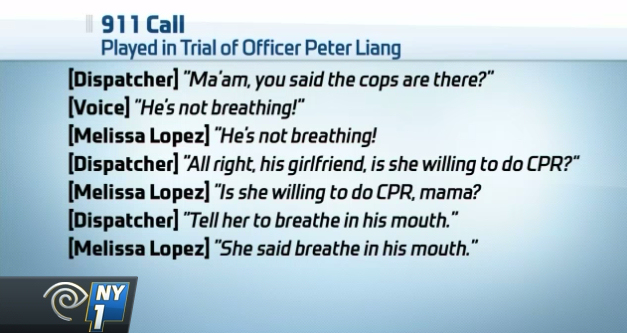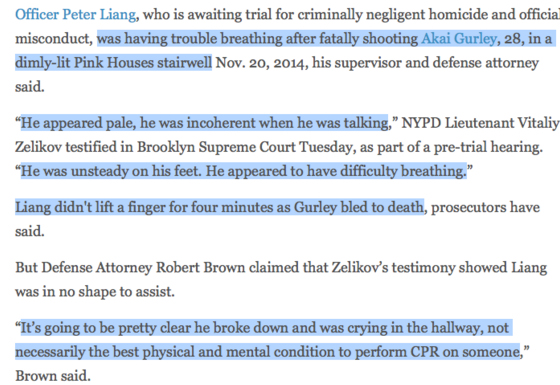
The manslaughter trial against Peter Liang — the police officer accused of manslaughter in the fatal shooting of Akai Gurley, an unarmed Black man killed when Liang opened fire with his service weapon in a darkened stairwell — began yesterday with opening statements by both the prosecution and the defense, and the calling of two witnesses. Liang’s case has been viewed as one of several examples of state violence against Black bodies in recent years, and several activists (including myself) have rallied in support of the Gurley family in calling for Liang and all other police involved in suspicious shootings against unarmed Black citizens to face criminal accountability. Late last year, news media reported that Liang had elected to face a jury trial in the case against him, and in the last week, jury selection resulted in a juror pool consisting of only one African American jury member and no Asian Americans.
Although many Asian Americans — including signatories of this open letter organized by CAAAV — have sided with Black Lives Matter activists in seeking #JusticeForAkaiGurley, Liang’s case has also attracted a surprising reaction from some within our community. Some Chinese Americans have come out in defense of Liang’s actions, arguing that Liang’s trial is evidence of systemic racial bias and demanding that the charges against him be dropped.
Liang’s supporters seemed largely unswayed by the details that have emerged about the fateful moment in the stairwell of Louis H. Pink Houses in late 2014 that left Akai Gurley dead by the police officer’s hand.
Late last year, a lengthy investigation into the shooting of Akai Gurley revealed that Liang and his partner, Shaun Landau, were conducting a vertical patrol of the stairwell when Liang shot into the dark, claiming that he had been startled and that his firearm had accidentally discharged. Yet, the investigation found that Liang’s handgun required 11.5-lbs of force to pull the trigger — on the high end of the range required for police service weapons and more than twice the trigger force required for a commercially available handgun — making an accidental discharge unlikely. In addition, Liang and his partner had both been trained not to place their fingers in the trigger well of their service weapons until they were ready to fire a shot.
More damning, however, are Liang’s actions following the shooting of his service weapon into a highly-trafficked residential area. Immediately after Liang fired the bullet that killed Akai Gurley, who had entered the stairwell below Liang, Liang and Landau spent several minutes arguing about what to do and whom to call even though policy dictates that a supervisor is to be notified as soon as a service weapon is discharged in the field. They ultimately chose not to call a supervisor but instead texted a union rep and then went into the stairwell to recover the bullet and casing, which is when they discovered Gurley bleeding to death. At that point, Liang and Landau failed to call an ambulance, or give CPR or any other sort of potentially life-saving measures as they are trained to do; instead, they stepped over a dying Gurley to speak with Melissa Lopez, a housing emergency service worker and the Pink Houses resident who called 911 after Gurley’s friend knocked on doors seeking help. A recording of Lopez’s 911 call shows that even though trained police were on the scene, Gurley’s panicked friend was being advised on how to administer resuscitation measures.

In the prosecution’s dramatic opening statement, Assistant District Attorney Marc Fliedner argued that Liang fired recklessly and did nothing when he realized he had shot an innocent man. Kneeling before jurors in a dramatic reenactment, Fleidner said of Liang:
“This man had just shot an innocent man, and he never even knelt to try and undo what he had done. To look into his dying eyes. To, even touch him.”
Defense attorneys argued that Liang was justified in having his service weapon out because he was about to patrol the Pink Houses’ roof, and that the shooting was a “one in a million” accident. They further suggested in their opening statement that, according to accounts by his fellow police officers, Liang never administered first aid to Gurley because he was too emotionally upset. Buzzfeed’s Mary Georgantopoulous, who was among several journalists live-tweeting the trial yesterday, posted this excerpt from the defense:
#PeterLiang, after shooting is so shocked, he's "in no shape to take care of himself let alone anyone else" Koshetz says. #AkaiGurley
— Mary Ann Georgantopoulos (@marygeorgant) January 25, 2016
In an earlier news media report, defense attorneys elaborated on this line of argument.

This description of Liang’s emotional state became the first point of contention between prosecution and defense. In contrast to the defense’s argument, Melissa Lopez testified yesterday that Liang was not upset and crying. Rather, according to Lopez, Liang appeared to be the opposite. NY Daily News reporter C.C. Woodby live-tweeted the following excerpt from Lopez’s testimony:
Lopez testified that #peterliang was not crying and was able to speak to her. He walked around #akaigurley dead body to ask for the address
— Christina Carrega (@ChrisCarrega) January 25, 2016
The defense probed Lopez’s testimony, contrasting it to earlier statements where she had apparently suggested Liang was “dumbfounded” or “stuck”.
In past statement, Lopez described #PeterLiang as “dumbfounded” “stuck” after shooting #AkaiGurley
— Mary Ann Georgantopoulos (@marygeorgant) January 25, 2016
Defense probes Lopez on her meaning of "stuck" vs. "Shock" when describing #peterliang demeanor
— Christina Carrega (@ChrisCarrega) January 25, 2016
Regardless, Lopez’s account seems to contradict the defense’s argument that Liang was “crying in the hallway”, and therefore too distraught to administer potentially life-saving measures for Gurley. It seems to me that if one has enough presence of mind to ask for an address, one has enough presence of mind to try and save the life of a man one has just shot and who is bleeding to death at one’s feet. Just sayin’.
The trial continues today, and reporters will continue to be live-tweeting at #PeterLiang.
